
The St. George Call was a weekly English language newspaper published from 1904 to 1979 in the St. George and Woronora electorates of New South Wales, Australia.

The St. George Call was a weekly English language newspaper published from 1904 to 1979 in the St. George and Woronora electorates of New South Wales, Australia.
The first issue of The St. George Call was published on Saturday, 9 January 1904. [1] The initial cost of a weekly issue was one penny. [1]
The first editorial on page 4 of the paper acknowledged the growing need within the local community for "...a representative local organ... so often expressed, and so generally felt...". [2] The hitherto lack of representation of the area in print was cited in the editorial with the community described as "...of insufficient importance for the city press." [2] Promising to comment without favour on local issues, the paper's editors aimed to "...criticise boldly whatever we consider amiss in the public affairs of our steadily progressing district". [2]
The publication ceased on 25 October 1979. [3]
Issues of The St. George Call from 1904 to 1957 have been digitised as part of the Australian Newspaper Digitisation Program of the National Library of Australia.

The Sydney Morning Herald (SMH) is a daily tabloid newspaper published in Sydney, Australia, and owned by Nine. Founded in 1831 as the Sydney Herald, the Herald is the oldest continuously published newspaper in Australia and claims to be the most widely-read masthead in the country. The newspaper is published in compact print form from Monday to Saturday as The Sydney Morning Herald and on Sunday as its sister newspaper, The Sun-Herald and digitally as an online site and app, seven days a week. It is considered a newspaper of record for Australia. The print edition of The Sydney Morning Herald is available for purchase from many retail outlets throughout the Sydney metropolitan area, most parts of regional New South Wales, the Australian Capital Territory and South East Queensland.

The West Australian is the only locally edited daily newspaper published in Perth, Western Australia. It is owned by Seven West Media (SWM), as is the state's other major newspaper, The Sunday Times. It is the second-oldest continuously produced newspaper in Australia, having been published since 1833. It tends to have conservative leanings, and has mostly supported the Liberal–National Party Coalition. It has Australia's largest share of market penetration of any newspaper in the country.

The Courier-Mail is an Australian newspaper published in Brisbane. Owned by News Corp Australia, it is published daily from Monday to Saturday in tabloid format. Its editorial offices are located at Bowen Hills, in Brisbane's inner northern suburbs, and it is printed at Yandina on the Sunshine Coast. It is available for purchase both online and in paper form throughout Queensland and most regions of Northern New South Wales.
The Illawarra Mercury is a daily newspaper serving the Illawarra region of New South Wales, Australia. It has been published since 1855, making it one of Australia's oldest newspapers and the second oldest regional newspaper in New South Wales. It has been published daily since December 1949, and has had no local daily competition since the 1960s. It has strong links to the Illawarra community.
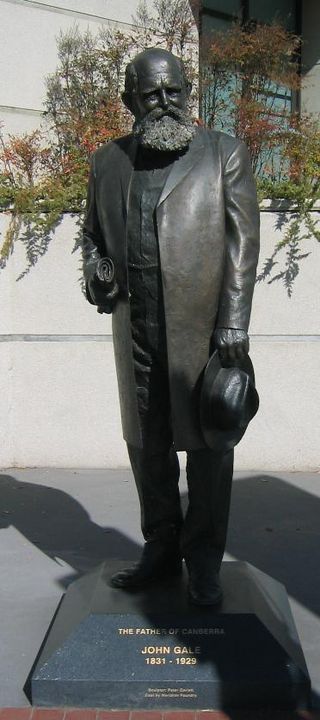
The Queanbeyan Age is a weekly newspaper based in Queanbeyan, New South Wales, Australia. It has had a number of title changes throughout its publication history. First published on 15 September 1860 by John Gale and his brother, Peter Francis Gale, The Golden Age, as it was known at the time, was the first newspaper of the small township on the banks of the Queanbeyan River. It was named due to the short-lived Kiandra goldrush, which generated large amounts of gold-based traffic through the region.

The Sydney Gazette and New South Wales Advertiser was the first newspaper printed in Australia, running from 5 March 1803 until 20 October 1842. It was a semi-official publication of the government of New South Wales, authorised by Governor Philip King and printed by George Howe. On 14 October 1824, under the editorship of Robert Howe, it ceased to be censored by the colonial government.
The Register, originally the South Australian Gazette and Colonial Register, and later South Australian Register, was South Australia's first newspaper. It was first published in London in June 1836, moved to Adelaide in 1837, and folded into The Advertiser almost a century later in February 1931.

The Daily Advertiser is the regional newspaper which services Wagga Wagga, New South Wales Australia and much of the surrounding region. It is published Monday to Friday but also appears as a sister publication called The Weekend Advertiser on Saturdays. The paper reaches about 31,000 people during its Monday to Friday printing, equating to 85% of all people aged over 14 that live in the paper's main coverage area.
The Maitland Mercury is Australia's third oldest regional newspaper, preceded only by the Geelong Advertiser and the Launceston Examiner . The Maitland Mercury was established in 1843 when it was called The Maitland Mercury and Hunter River General Advertiser. The Maitland Mercury is still in circulation serving the city of Maitland and the surrounding Lower Hunter Valley. It has a weekly print edition which appears on Fridays.
The Queensland Times is an online newspaper serving Ipswich and surrounds in Queensland, Australia. The newspaper is owned by News Corp Australia. The circulation of The Queensland Times is 10,804 Monday to Friday and 14,153 on Saturday.
The Cumberland Argus and Fruitgrowers' Advocate was a newspaper published in Parramatta with coverage and circulation incorporating Greater Western Sydney and parts of North-West Sydney, Australia. First published on 24 September 1887, the paper continued under this title until issue No. 3397, on 15 March 1950, when the newspaper was officially renamed the Cumberland Argus. It remained under this banner for a further 12 years until it ceased publication on 24 October 1962.
The Western Herald is a print newspaper, published in Bourke, New South Wales, Australia. It services the town of Bourke and surrounding districts. The current cover price is $2.00.
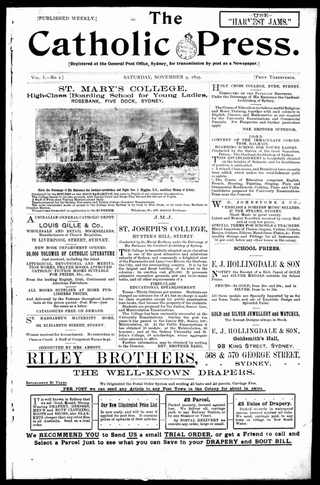
The Catholic Press was a Sydney-based newspaper that was first published on 9 November 1895 and ran until 26 February 1942, after which it amalgamated with the Catholic Freeman's Journal and was reborn as The Catholic Weekly.

The Farmer & Settler was an English-language broadsheet newspaper published in Sydney, Australia, between 1906 and 1957. It was primarily published weekly.
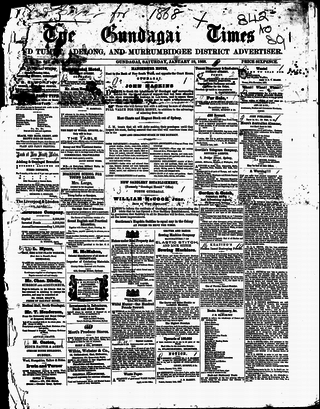
The Gundagai Times and Tumut, Adelong, and Murrumbidgee District Advertiser, often referred to as simply the Gundagai Times, was a newspaper published in Gundagai, New South Wales, Australia from 1868 to 1931. It was a direct successor of The Wynyard Times and Tumut and Adelong Advertiser and The Tumut and Adelong Times, published in Tumut, New South Wales, and was absorbed into The Gundagai Independent in 1931.
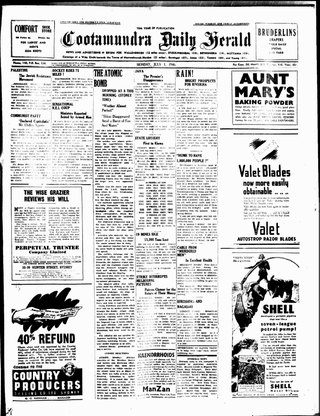
The Cootamundra Herald is a former printed bi-weekly newspaper now existing only on-line and containing little or no news of direct relevance to the community of Cootamundra, New South Wales, Australia. The Herald website carries syndicated non-local copy with occasional government media releases referring to local issues. Following the purchase of the masthead in 2019 by Australian Community Media, the Herald office which had existed for 144 years in the main street was closed and local staff were forced to work part-time from home. The staff resigned or were eventually sacked, and there are now no local Herald employees generating content related to the town.
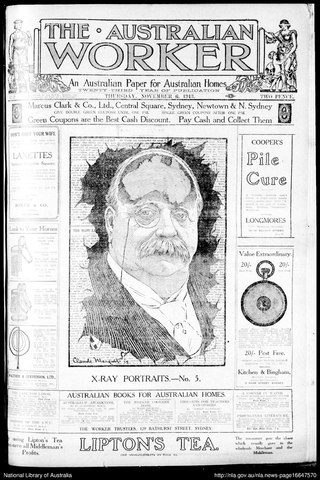
The Australian Worker was a newspaper produced in Sydney, New South Wales for the Australian Workers' Union. It was published from 1890 to 1950.
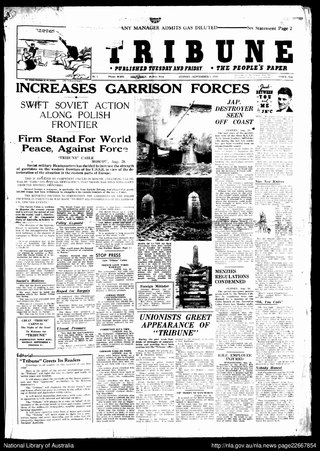
Tribune was the official newspaper of the Communist Party of Australia. It was published by the Central Committee of the Communist Party of Australia from 1939 to 1991. Initially it was subtitled as Tribune: The People's Paper. It was also published as the Qld Guardian, Guardian (Melbourne), Forward (Sydney). It had previously been published as The Australian Communist, (1920-1921) The Communist, (1921-1923) and the Workers' Weekly (1923-1939).
The Auburn News and Granville Electorate Gazetteer was an English-language local newspaper published from 1903 to 1907 in Auburn, Sydney, Australia, circulating in Auburn, Rookwood, Silverwater, Newington, Clyde, Granville, Bankstown, Parramatta, in Sydney, as well as other metropolitan, interstate and overseas locations. The masthead proclaimed that the paper had "No sect, creed or party but for the good of all." The paper primarily reported on social, community, sporting and local government activities in the Granville Electorate, including the towns of Auburn, Rookwood, Granville and Bankstown, and included local business and classified advertising.
The Express was a free English language local community tabloid newspaper, printed and published weekly by Herbert Denley, at 58 Good Street, Granville, New South Wales, Australia. The newspaper circulated in the suburbs of Auburn, Lidcombe, Berala, Regents Park, Flemington, Homebush and surrounding districts, reporting on social, community, sporting and local government activities, and provided local business and classified advertising.